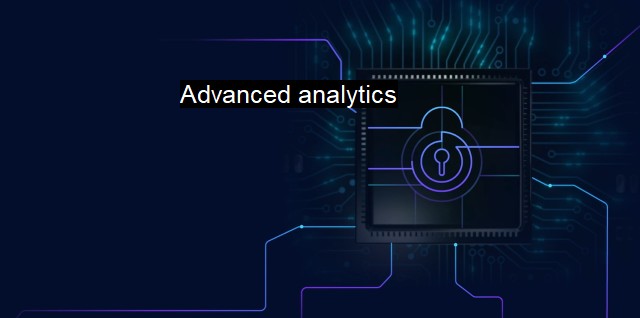What are Advanced analytics?
Unleashing the Power of Advanced Analytics in Cybersecurity: A Comprehensive Insight into XDR and AI-based Antivirus Software
Advanced analytics refers to an intricate examination of data or content using advanced statistical techniques and computational measurements. These advanced methods comprise machine learning, pattern matching data mining and predictive and prescriptive analytics, among others. advanced analytics play a significant role in safeguarding information and digital systems from harmful viruses, malware, and other cyber threats.Advanced analytics can detect anomalies, trends, and patterns that are not easily visible or interpretable through conventional analytics. This powerful tool facilitates real-time, proactive security measures, helping the business enable its growth safely amidst the evolving threat environment. The technology aids in transforming accumulated raw data into pertinent and practical insights that can better predict attacks and construct enhanced security measures around sensitive business data.
In the cybersecurity context, specifically, the application of advanced analytics lets companies employ predictive models to understand the probability of future risks and incidents. Curating the algorithms over time helps them to use both historical and real-time data to identify previously unknown threats. This advanced analytics mechanism recognizes patterns or qualities indicative of potential risks or contaminants that may compromise the security of an information system.
One of the main advantages of applying advanced analytics in cybersecurity systems is the efficiency to identify threats before they infiltrate or harm an organization’s digital shields. The software can spot patterns and predict actions, assisting security personnel to take necessary safety procedures proactively. A real-time improvised threat detection system can make all the difference in mitigating, neutralizing, or even averting catastrophic attacks.
Also, advanced analytics operates on high-end statistical models combined with machine learning tools to define normal user behavior. These models can spot any anomalies in usual activities that may signal a potential security breach. the undertaking includes analyzing and segregating security events based on severity using significant data points essential for recognizing potential threats.
When integrated with antivirus software, advanced analytics increase the effectiveness and efficiency of virus detection and removal. Antivirus programs typically involve signature-based detection systems, examining files that match with known harmful programs. With advanced analytics, antivirus software is capable of recognizing threats that don't match with prior known 'signatures'. Known as heuristic file scanning, it permits the antivirus to identify harmful software based solely on their behavior.
The application of advanced analytics in detecting wide-ranging virus attacks also empowers data forensics. It aids in gathering valuable clues to examine how precisely an attack occurred, the tactics used by the attackers, and where they originated from. Such insights can enhance an organization’s approach to threat handling, optimizing its cybersecurity investments and helping them to strengthen their security infrastructure.
A crucial benefit of extending advanced analytics to antivirus technology is that it allows the software to learn and grow over time. The more analytical data these tools accumulate, the more their detection capabilities can evolve, consistently improving their efficacy in response to an ever-more sophisticated threat landscape.
Advanced analytics is a multifaceted tool that leverages complex projective and speculative techniques to bolster cybersecurity measures and reinforce antivirus safeguards. By leveraging its power, businesses can fortify their cybersecurity infrastructure, efficiently identifying and neutralizing threats before they cripple their systems. Meanwhile, the continual evolution of this technology signifies a promising future for digital defense mechanisms amidst an increasingly hazardous digital environment.

Advanced analytics FAQs
What is advanced analytics in the context of cybersecurity and antivirus?
Advanced analytics in the context of cybersecurity and antivirus refers to the use of sophisticated analytical techniques such as machine learning, artificial intelligence, and data mining to identify potential security threats and malware attacks. It involves analyzing large volumes of data to detect anomalies, patterns, and trends that may indicate a breach or an attack.How does advanced analytics improve cybersecurity and antivirus protection?
Advanced analytics improves cybersecurity and antivirus protection by enabling organizations to detect and respond to threats faster and more accurately. It allows for real-time monitoring and analysis of data, which helps identify unusual behavior and potential attacks. Advanced analytics also helps to build predictive models that can anticipate future attacks and provide recommendations for proactive measures to prevent them.What are some examples of advanced analytics in cybersecurity and antivirus?
Some examples of advanced analytics in cybersecurity and antivirus include anomaly detection, behavior analytics, threat intelligence, and predictive modeling. Anomaly detection involves identifying patterns of behavior that are outside of the norm and may indicate a security threat. Behavior analytics looks at user behavior and network activity to detect and prevent insider threats. Threat intelligence involves analyzing data from multiple sources to identify and track threats to the organization. Predictive modeling uses machine learning to anticipate future threats and provides recommendations for proactive measures to mitigate them.What are the benefits of using advanced analytics in cybersecurity and antivirus?
The benefits of using advanced analytics in cybersecurity and antivirus include improved threat detection and response times, reduced false positives, enhanced predictive capabilities, and better overall security posture. Advanced analytics enables organizations to stay ahead of emerging threats and stay proactive in their security measures. It also helps optimize security resources and reduce costs associated with security incidents.| | A | | | B | | | C | | | D | | | E | | | F | | | G | | | H | | | I | | | J | | | K | | | L | | | M | |
| | N | | | O | | | P | | | Q | | | R | | | S | | | T | | | U | | | V | | | W | | | X | | | Y | | | Z | |
| | 1 | | | 2 | | | 3 | | | 4 | | | 7 | | | 8 | | |||||||